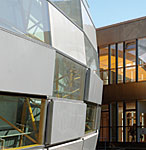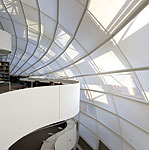Robo Buildings: Pursuing the Interactive Envelope
"I think such worries are well-founded," counters Bruce Nichols, a principal of the New York City−based facade consultancy Front Inc. "While an automobile maker is a single source of responsibility, that doesn't happen in architecture." He recounts his work with the Japanese firm SANAA on a competition-winning office building for the Novartis campus in Basel, Switzerland. For its transparent triple glazing with integral automated ventilation and Venetian blinds, the shades came with only five-year warranties; the glass was guaranteed for at least 10 years. So, if a shade fails after five years, Novartis would have to pay for replacing a glass unit just to access the defective shade. "We asked the manufacturers if they could get their act together to offer a collective warranty," Nichols recalls. "They couldn't."
Beyond famous failures, high installed costs, and mismatched warranties lay big coordination challenges, adds Nichols, and conflicting liabilities among project team members. Plainly, the road to the interactive envelope is a rough one. But at the end of the ride, optimal energy performance is the payoff, right? So it is hoped. Yet Lee warns there is shockingly little postoccupancy data to confirm initial design claims on older projects.
Sun-tracking systems lead the way
While animated as much by polemics as by actuators, new interactive envelopes still have fervent supporters. A single, conventional application gets most of the credit for the good buzz: daylighting control. On its own, an operable shade or louver is easy for an architect to analyze, especially with new daylight analysis tools built into common CAD platforms. The overarching driver for most automated shading is the typical energy profile of large commercial buildings, according to LBNL. Cooling loads dominate, with more than two thirds needed simply to counteract heat gain from lighting systems and sun-loaded glass surfaces.
Also encouraging the use of interactive envelopes is the solid performance of photosensors, dimmable lighting controls, and novel solar-tracking devices. More recent advances include switchable glazings, sometimes called "smart windows." These automatically tint or frost, activated by either an applied voltage (electrochromic) or a small release of gas, such as hydrogen (gasochromic). The former type is more widely available, but both can reduce combined cooling and lighting loads by up to 5 watts per square foot in interior perimeters.
Another appeal of automated shading relates to the feasibility of the highly transparent, relatively unarticulated building enclosures currently in fashion. For Arizona State University's Biodesign Institute in Tempe, collaborators at Gould Evans and Lord Aeck Sargent Architecture compensated for a large easterly expanse of window walls by using interior aluminum louvers controlled continuously by photocells and sun-tracking software. A manual override accessible through occupants' computers allows personal adjustments to be made.
Is intelligent shading worth the bother? LBNL tests suggest so. Automated daylight setups coupled with dimmable and switchable electrical lighting beat conventional fixed blinds in terms of energy draw by about a third in winter and up to 52 percent in summer. Measured daylighting levels are comparable to those for unshaded bronze glazing, with only half the solar heat gain. Lee adds that the systems allow building managers to voluntarily curtail electrical loads as part of utility demand-response programs, which help avert blackouts.













